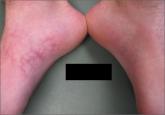The biopsy the local dermatologist took did not show any signs of an infectious disease. The physicians at the regional dermatology clinic recognized that the lesions were distributed only in places the patient could reach, and felt the wounds were self-inflicted. When they asked the patient about this with her mother in the room, she denied any self-injury. At the girl’s next appointment with a different physician, she was asked about self-injury without her mother in the room, and she admitted to injuring herself using the “salt and ice challenge.”
The salt and ice challenge involves putting salt on a person’s skin and then laying ice cubes on top of the salt, which can result in a form of frostbite.1,2 This “challenge” has become a dare among teens to see how long they can withstand the pain of the burn. In one case, a 12-year-old boy suffered third-degree burns in the shape of a cross on his back after withstanding the “challenge” for 20 minutes.1
As this case illustrates, the burns from the salt and ice challenge might be difficult to distinguish from a rash without an accurate history from a patient or caregiver. Suspect a salt/ice burn in patients who have lesions with sharply demarcated borders that may be blistered in appearance or have bullous like characteristics.3,4 Unlike most rashes, a burn typically will not itch until well into the healing process.
